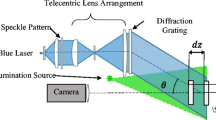Abstract
The requirements of a high-speed recording system in dynamic photoelastic studies are closely met with a Cranz-Schardin camera. This camera, which operates at framing rates between 32,000 and 815,000 frames/sec, is capable of resolving a dynamic fringe pattern with a fringe gradient of 20 fringes/in. traveling with a velocity of 75,000 ips. Design details of the Cranz-Schardin system are given, and typical results obtained are illustrated.
Similar content being viewed by others
Author information
Authors and Affiliations
Rights and permissions
About this article
Cite this article
Riley, W.F., Dally, J.W. Recording dynamic fringe patterns with a Cranz-Schardin camera. Experimental Mechanics 9, 27N–33N (1969). https://doi.org/10.1007/BF02327718
Issue Date:
DOI: https://doi.org/10.1007/BF02327718




